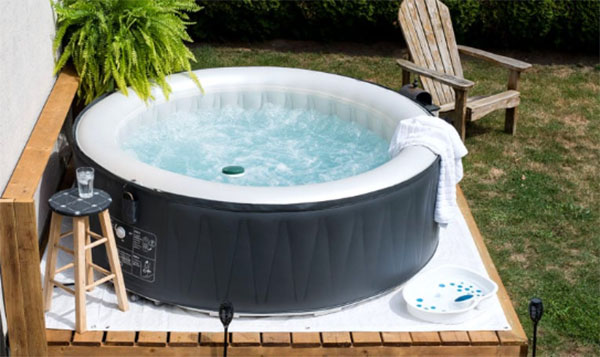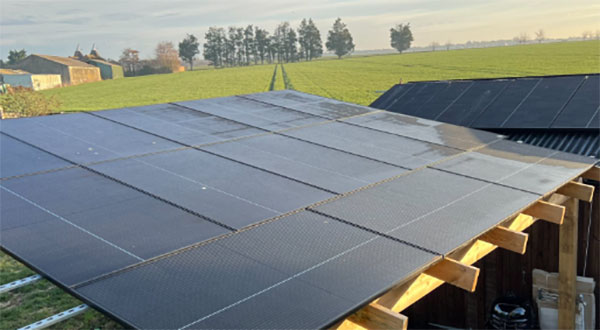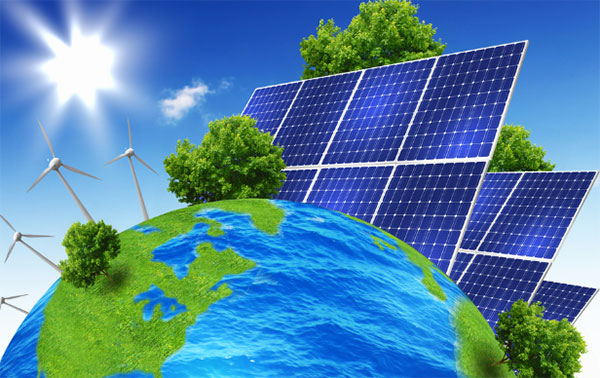Description
Yes, you can power a hot tub with solar panels, considering adequate panel capacity, efficient batteries, and proper system installation.
Understanding Solar Energy for Hot Tubs
Solar energy provides a sustainable and cost-effective way to power various appliances, including hot tubs. Transitioning your hot tub to solar power involves understanding the basics of solar energy and recognizing the multiple benefits it offers.
Basics of Solar Power
Solar energy is harnessed through photovoltaic (PV) panels that convert sunlight into electricity. The power generated by these panels is measured in kilowatts (kW). An average hot tub requires around 3 to 5 kW, depending on its size and heating requirements. Solar panels come in various sizes and capacities, typically ranging from 250W to 400W per panel. Therefore, to meet the power needs of a hot tub, you would need an array of panels with a combined capacity of at least 3 kW. The efficiency of solar panels, which is a measure of their ability to convert sunlight into electricity, typically ranges between 15% to 20%. The cost of solar panels has been decreasing over the years, making them an increasingly viable option. On average, the price for a residential solar power system can range from $3 to $5 per watt, translating to a total investment of $9,000 to $15,000 for a system capable of powering a hot tub.
Benefits of Using Solar Energy for Hot Tubs
Switching to solar energy for powering a hot tub presents several advantages:
- Reduced Energy Bills: Solar power significantly cuts down on electricity costs. Although the initial setup cost may be high, the long-term savings on energy bills can be substantial.
- Eco-friendly: Solar energy is clean and renewable, reducing your carbon footprint and contributing positively to the environment.
- Low Maintenance Costs: Solar power systems require minimal maintenance, mainly involving periodic cleaning of panels and occasional checks of the system components.
- Increased Property Value: Homes with solar energy systems often enjoy a higher market value due to the desirable attribute of sustainable energy.
- Reliability and Longevity: Solar panels are durable and can last up to 25-30 years, ensuring a long-term energy solution for your hot tub.
Solar Power System Components for Hot Tubs
A solar power system for hot tubs is not just about panels; it involves an interconnected set of components, each playing a crucial role in ensuring efficient energy conversion, storage, and management. Understanding these components and their specifications is key to optimizing the system's performance and durability.
Solar Panels
Solar panels are the heart of the solar power system, capturing sunlight and converting it into electricity. For a hot tub, the required power is typically between 3 to 5 kW.
- Power and Efficiency: Panels with a power output ranging from 250W to 400W are commonly used. The efficiency, or the ability to convert sunlight into electricity, lies between 15% and 20%.
- Cost and Size: The cost per watt ranges from $3 to $5, meaning a full set for a hot tub can cost between $9,000 and $15,000. The size of each panel can vary, but a standard one is about 1.6 square meters.
- Durability: Most solar panels come with a warranty of 25-30 years, ensuring a long lifespan.
Batteries and Energy Storage
Batteries store the electricity generated by solar panels for later use, especially when the sun isn't shining. They are critical for maintaining a continuous power supply to the hot tub.
- Capacity and Lifespan: Battery capacity is measured in kilowatt-hours (kWh). A system for a hot tub might require a battery bank that can store at least 10-15 kWh to ensure consistent performance. Quality batteries can last between 5 to 15 years.
- Cost: The price for storage batteries can range from $400 to $750 per kWh, making the total cost for a sufficiently sized battery bank significant.
- Types of Batteries: Lithium-ion batteries are popular due to their high efficiency and long lifespan compared to lead-acid batteries.
Inverters and Controllers
Inverters and controllers are crucial for regulating the flow of electricity and converting it into a form that can be used by household appliances, including hot tubs.
- Functionality: The inverter converts the DC electricity generated by the solar panels into AC electricity, which is what most hot tubs require. Controllers manage the flow of electricity to and from the battery, ensuring that it's neither overcharged nor overly depleted.
- Efficiency and Cost: Inverters typically operate at an efficiency of 90% to 95%. The cost of a good quality inverter can range from $1,000 to $2,000.
- Specifications: When selecting an inverter and controller, ensure they match the system's voltage and power requirements. Also, consider getting devices with remote monitoring capabilities for easier management.
Installation and Setup
Proper installation and setup are crucial for maximizing the efficiency and longevity of your solar-powered hot tub system. This involves understanding your hot tub's specific energy requirements, planning the layout and positioning of solar panels, and ensuring a secure connection between the solar power system and the hot tub.
Assessing Your Hot Tub's Energy Requirements
The first step is to determine the exact energy needs of your hot tub, which directly influences the size and specifications of the solar power system you'll need. Key Points:
- Power Consumption: Average hot tubs require between 3 to 5 kW. Check the specifications of your hot tub to understand its exact power needs.
- Usage Patterns: Consider how often and for how long you use the hot tub, as this will affect the total energy consumption and the required capacity of your solar power system.
- Efficiency Considerations: Account for the efficiency of the solar panels and the potential loss in energy conversion and transmission. A buffer of 10-20% more capacity than the hot tub's rating is advisable to ensure adequate power supply.
Planning and Positioning Solar Panels
The effectiveness of solar panels is heavily dependent on their placement and orientation. Proper planning is essential for optimizing energy capture. Key Points:
- Orientation and Tilt: Panels should ideally face south (in the Northern Hemisphere) and be tilted at an angle equal to the latitude of your location to maximize sun exposure.
- Shading: Ensure that there are no obstructions such as trees or buildings that could cast shadows on the panels, especially during peak sunlight hours.
- Space Requirements: Each panel is about 1.6 square meters, so ensure you have adequate space for the number of panels required to meet your hot tub's energy needs.
Connecting the Solar System to Your Hot Tub
The final step is to integrate the solar power system with your hot tub, ensuring a safe and efficient connection. Key Points:
- Professional Installation: Given the complexity and safety concerns, professional installation is strongly recommended. This ensures that the system meets local building codes and safety standards.
- Electrical Wiring: Use appropriate gauge wiring and secure connections to handle the electrical load and minimize loss.
- System Testing: Once installed, the entire system should be thoroughly tested to ensure that it operates correctly and efficiently under different conditions.
Maintenance and Troubleshooting
Maintaining and troubleshooting your solar-powered hot tub system is essential for ensuring its long-term efficiency and performance. Regular maintenance can prevent most issues, but knowing how to address common problems is also crucial. Additionally, upgrading and enhancing your system over time can lead to better performance and energy savings.
Routine Maintenance for Solar-Powered Hot Tubs
Consistent maintenance is key to the longevity and efficiency of your solar power system. Key Points:
- Panel Cleaning: Dirt, leaves, and other debris can reduce the efficiency of solar panels. Regular cleaning, especially after storms or during periods of high pollen, is essential.
- System Inspection: At least once a year, have a professional inspect the system, including panels, wiring, batteries, and inverters, to ensure everything is in good working order.
- Battery Maintenance: For systems with batteries, check the charge levels and ensure the batteries are well-maintained, following the manufacturer's guidelines.
Common Issues and Solutions
Even with regular maintenance, issues can arise. Knowing the common problems and their solutions can save time and prevent damage.
- Reduced Power Output: Often caused by dirty or shaded panels. Regular cleaning and ensuring clear exposure to sunlight can solve this issue.
- Inverter Problems: Inverters can fail or become less efficient. Listen for unusual noises and monitor the inverter's display for error messages. Regular professional check-ups can prevent long-term issues.
- Battery Issues: If the system has batteries, reduced capacity or failure to hold a charge can indicate a problem. Ensure connections are tight and clean, and check the battery's health regularly.
Upgrading and Enhancing Solar Systems for Hot Tubs
As technology advances, upgrading your system can improve efficiency and reduce costs.
- Panel Upgrades: Newer panels have higher efficiency and longer lifespans. Consider replacing old panels if they are underperforming.
- Battery Technology: Upgrading to newer battery technology, like lithium-ion batteries, can offer longer life, higher efficiency, and larger capacity.
- Smart Controllers: Advanced controllers can optimize energy use, improve battery life, and even allow remote monitoring of your system.

Cost Analysis and Savings
Investing in a solar-powered hot tub system involves initial costs but can lead to substantial long-term savings and benefits. Understanding these costs, the potential savings over time, and available incentives can help you make an informed decision.
Initial Investment and Installation Costs
The upfront cost is a significant part of transitioning to solar energy, but it's an investment that can pay off over time. Key Points:
- Solar Panels: The cost of solar panels typically ranges from $3 to $5 per watt. For a system sufficient to power a hot tub (around 3 to 5 kW), the total cost for panels can be between $9,000 and $15,000.
- Batteries and Storage: If opting for energy storage, batteries can add $400 to $750 per kWh to the total cost. A 10-15 kWh battery bank can cost between $4,000 and $11,250.
- Installation and Additional Components: Costs for inverters, controllers, wiring, and professional installation can vary but expect to add several thousand dollars to the total investment.
- Total Initial Cost: Combining all these elements, the initial cost can range from $15,000 to $30,000 or more, depending on system size and component choices.
Analyzing Long-term Savings
The long-term savings from a solar-powered hot tub can be substantial, offsetting the initial investment over time.
- Reduced Energy Bills: Solar power can significantly reduce or even eliminate the electricity costs associated with running a hot tub.
- Increased Property Value: Homes with solar energy systems often have higher market values and can be more attractive to buyers.
- Maintenance Costs: While there are some maintenance costs, they are generally low compared to the ongoing costs of traditional electricity.
- Break-even Point: Depending on your local electricity rates and the efficiency of your system, the break-even point can vary. However, most systems pay for themselves within 5 to 15 years.
Incentives and Rebates for Solar Energy Systems
Various incentives can help reduce the initial cost of installing a solar power system.
- Federal Tax Credits: In many countries, including the United States, homeowners can claim a significant percentage of the cost of the solar system as a tax credit.
- State and Local Incentives: Many states and local governments offer additional incentives, rebates, or grants for solar energy systems.
- Net Metering: In some regions, you can sell excess power back to the grid, further offsetting your costs.







